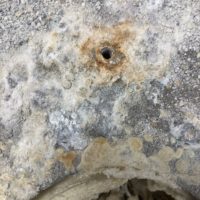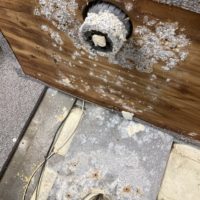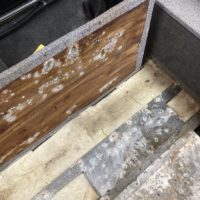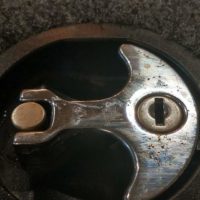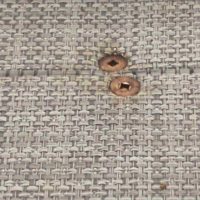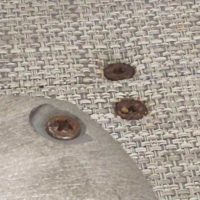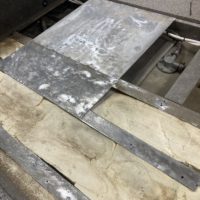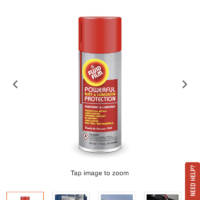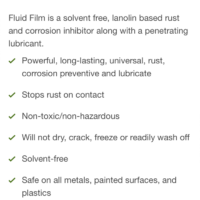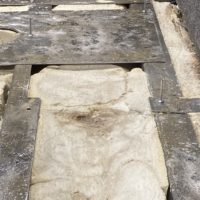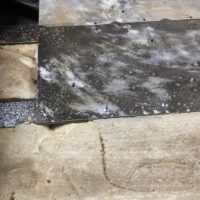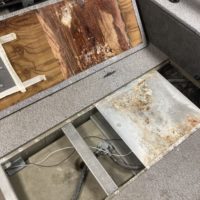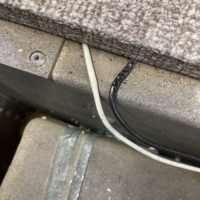2018 competitor 175, always garage kept. Took the floor up today to run some wires and was greeted with this surprise. Hate to see it after eight years! They must have used pressure treated wood instead of real marine grade. I think I heard that pressure treated is corrosive to aluminum.
IDO » Forums » Fishing Forums » General Discussion Forum » Four years, what a shame!
Four years, what a shame!
-
July 23, 2022 at 11:11 pm #2137284
You can see the pitting in the metal after I scraped and wire brushed it
 DTW
Posts: 296July 23, 2022 at 11:41 pm #2137287
DTW
Posts: 296July 23, 2022 at 11:41 pm #2137287I t looks like an electrolysis issue from your pics. If your hull has pitting, you most likely will need to install or replace a sacrificial anode. All engines have them. Most by the lower unit. Different metals will produce an electric current when in contact with each other. This creates a depletion of the ‘weaker’ metal. A zinc or magnesium sacrificial anode will probably take care of your problems.
Or maybe it’s just your plywood
July 24, 2022 at 6:29 am #2137289I would definitely send these pictures to the dealer and manufacturer.
 Red Eye
Posts: 885July 24, 2022 at 7:21 am #2137292
Red Eye
Posts: 885July 24, 2022 at 7:21 am #2137292Guy i work with ordered a 185 competitor tiller. Waited 15 months for it to arrive. Has had it a total of 5 WEEKS. It has never sat outside since he’s had it. His looks like this. He is not happy as you could imagine. He said the corrosion around the gauges is so thick you can scrape it off with your finger nail. Most every screw in the floor and seat bases are rusting.
July 24, 2022 at 7:31 am #2137297Guy i work with ordered a 185 competitor tiller. Waited 15 months for it to arrive. Has had it a total of 5 WEEKS. It has never sat outside since he’s had it. His looks like this. He is not happy as you could imagine. He said the corrosion around the gauges is so thick you can scrape it off with your finger nail. Most every screw in the floor and seat bases are rusting.
That’s crazy! My screws are all still shiny, I believe they are stainless steel. Those are definitely not stainless.
 matt
Posts: 659July 24, 2022 at 7:32 am #2137298
matt
Posts: 659July 24, 2022 at 7:32 am #2137298I found the same thing in a few places on a Lund I purchased a couple months ago,it is a 1998.I have not pulled the whole floor on it but the corrosion was the worst where the plywood was in direct contact with the aluminum and in places where the wood did not dry or could not easily dry out.From what I saw on the Lund I am pretty sure its caused by the plywood,looks to be in your case as well.
July 24, 2022 at 7:56 am #2137300I’m going to paint the bottom of the plywood and I found some rust inhibitor that says it can be used on paint so hopefully that they will work together to separate the two. I’ve got to put some new rivets in also, what a pain! I only wanted to run some wires for a onboard alternator charger and it escalated quickly.
 mrpike1973
Posts: 1427July 24, 2022 at 7:59 am #2137305
mrpike1973
Posts: 1427July 24, 2022 at 7:59 am #2137305You got me worried now. Did you just drill out the pop rivets? Always thought about pulling mine up just to see. Boy that is gut wrenching.
July 24, 2022 at 8:03 am #2137307I t looks like an electrolysis issue from your pics. If your hull has pitting, you most likely will need to install or replace a sacrificial anode. All engines have them. Most by the lower unit. Different metals will produce an electric current when in contact with each other. This creates a depletion of the ‘weaker’ metal. A zinc or magnesium sacrificial anode will probably take care of your problems.
Or maybe it’s just your plywood
Thanks, both my main and my kicker have sacrificial anode’s so I’m not sure that’s the problem, I did just look at them and they are chalky. I wonder if they should be cleaned up.
 stevenoak
Posts: 1709July 24, 2022 at 8:04 am #2137309
stevenoak
Posts: 1709July 24, 2022 at 8:04 am #2137309Do you tow it in the winter when the roads are salty? My ice hut was 20 years old in new condition. Till I hauled it in the back of the truck one time during a snow, before I got my topper on the truck. The next spring the galvanized metal looked like I pulled it out of the ocean.
July 24, 2022 at 8:09 am #2137311You got me worried now. Did you just drill out the pop rivets? Always thought about pulling mine up just to see. Boy that is gut wrenching.
No just screws but lots of rivets are corroded away.
July 24, 2022 at 8:10 am #2137312Do you tow it in the winter when the roads are salty? My ice hut was 20 years old in new condition. Till I hauled it in the back of the truck one time during a snow, before I got my topper on the truck. The next spring the galvanized metal looked like I pulled it out of the ocean.
No, just spring,summer,and fall
July 24, 2022 at 8:43 am #2137316That’s why they shouldn’t be using wood as a component to build boats anymore. Some manufacturers stopped years ago but clearly some are still doing it.
July 24, 2022 at 8:49 am #2137317That stinks, I’ve seen it before on the alumacrafts, had a couple come back with similar issues, that also can be caused by stray voltage within the boat is what the manufacturer told us. So I would check over the wiring grounds etc.. if it were me before I put the plywood back down I would use a membrane like you would use on a deck ledger board on a house on the back side of the plywood between the aluminum and wood. Definitely stinks!
July 24, 2022 at 10:43 am #2137326You got me worried now. Did you just drill out the pop rivets? Always thought about pulling mine up just to see. Boy that is gut wrenching.
Here are the missing rivets. Seven total.
 mrpike1973
Posts: 1427July 24, 2022 at 12:30 pm #2137335
mrpike1973
Posts: 1427July 24, 2022 at 12:30 pm #2137335….
that also can be caused by stray voltage within the boat ….. So I would check over the wiring grounds etc..X2. All grounds should go through wiring back to the battery, nothing should be grounded to the hull.
It is highly unlikely they used treated plywood. Marine plywood is untreated wood like standard plywood but has more layers than standard plywood, has no voids in the layers and uses water/boil resistant adhesives. There are likely some chemicals in marine plywood that could react with aluminum when wet. My 2003 Pro-V had some aluminum pitting when I replaced the transom but not as bad as yours, no missing rivets, etc. and the marine plywood was largely rotted out. The amount of corrosion you are experiencing (including missing rivets) sure seems like more than would be expected without some “electrical assistance “.
July 24, 2022 at 12:50 pm #2137338Same song, second, third,fourth……verse and it goes on and on with so many manufacturers. Don’t give a crap. They have your money, it lasted through warranty, so it’s your problem-not theirs. Cars, trucks,boats, reels, equipment..all the same. Build it cheap, maximize profits, keep shareholders happy and screw the consumer
July 24, 2022 at 1:12 pm #2137341<div class=”d4p-bbt-quote-title”>gregory wrote:</div>
….
that also can be caused by stray voltage within the boat ….. So I would check over the wiring grounds etc..X2. All grounds should go through wiring back to the battery, nothing should be grounded to the hull.
It is highly unlikely they used treated plywood. Marine plywood is untreated wood like standard plywood but has more layers than standard plywood, has no voids in the layers and uses water/boil resistant adhesives. There are likely some chemicals in marine plywood that could react with aluminum when wet. My 2003 Pro-V had some aluminum pitting when I replaced the transom but not as bad as yours, no missing rivets, etc. and the marine plywood was largely rotted out. The amount of corrosion you are experiencing (including missing rivets) sure seems like more than would be expected without some “electrical assistance “.
Yes nothing is grounded to the hull, BUT the motor is grounded to the battery and the motor is bolted to the hull. I would think all aluminum boats are in fact grounded to the hull through the motor indirectly.
July 24, 2022 at 1:21 pm #2137343When I pulled the floor up I found the wires that the dealer used to extend the onboard charger. They were way to small and they smashed them under the floor, think it’s possible that this was causing electrolysis. The wires were pretty smashed and damaged.
July 24, 2022 at 2:26 pm #2137352Yes nothing is grounded to the hull, BUT the motor is grounded to the battery and the motor is bolted to the hull. I would think all aluminum boats are in fact grounded to the hull through the motor indirectly.
My understanding is the the negative cable from the battery is attached to the engine and the mounting bracket and lower unit are electrically isolated from the engine (and thus the battery).
July 24, 2022 at 4:21 pm #2137355<div class=”d4p-bbt-quote-title”>Gino wrote:</div>
Yes nothing is grounded to the hull, BUT the motor is grounded to the battery and the motor is bolted to the hull. I would think all aluminum boats are in fact grounded to the hull through the motor indirectly.My understanding is the the negative cable from the battery is attached to the engine and the mounting bracket and lower unit are electrically isolated from the engine (and thus the battery).
If the battery cables are in good shape, properly installed and sized, the engine electrical system will use the negative battery cable as it’s path to ground. If not then the electricity finds the next best path back to the battery. The connection of the engine to the hull, through the transom and mounting bolts, would be more of a bonding circuit.
It definitely looks like there is some electrolysis at play. If some part of the electrical system is grounding through the hull this stuff can happen in a hurry under the right conditions. It will also be worse where dissimilar metals are in contact, and where moisture gets trapped. The battery charger leads if shorted to the hull could definitely be the cause. A multimeter can be used to check for stray current. You can then disconnect accessories until the amperage is gone.
July 24, 2022 at 8:20 pm #2137367How exactly would you do that, I have a nice digital multi meter but I’ve been reading on it and it seems every one has a different method of checking for voltage. One I seen was to take a grounding rod and pound in the ground and connect one lead of the multi meter to that and then disconnect you negative wires from the battery, turn on each circuit while checking for voltage. Is there a way to do this without pounding a grounding rod into the ground?
July 25, 2022 at 8:11 am #2137388magnesium sacrificial anode
We always hear the word zinc but in fresh water it’s best to us magnesium and yes, the chalk should be cleaned off each year. It doesn’t require removal, just sand paper or a wire wheel.
Anodes can be placed on the hull as well.
I have magnesium anodes on my drive shafts, rudders and hull. Not to mention in my generator, water heater and water coolers (the radiator on an inboard).Some are changed every year because the are 3/4 gone.
July 25, 2022 at 9:08 am #2137408Disconnect the engine battery cables to eliminate a potential ground/bonding circuit. Make sure they’re isolated from the hull(ring terminals aren’t touching anything). The goal is to completely isolate the hull from any potential connection to the battery grounds. If there where any intentional bonding wires from the hull to the battery ground circuit they would have to be disconnected as well.
Next put a meter lead to the hull (make sure it’s bare clean aluminum). Put the other meter lead to the negative battery post. With everything on do you get a current reading? If you do something is trying to use the hull for a ground path. Start disconnecting or turning off accessories one at a time while watching your meter. If the current goes to zero that accessory circuit would potentially be the issue. No accessories should be using the hull as a ground path.
This could still be something leaching out of the wood floor and reacting with the aluminum considering the damage is isolated to those areas per the pics, but those are also the areas that retain moisture and would make an electrolysis problem worse.
July 25, 2022 at 9:41 am #2137425Disconnect the engine battery cables to eliminate a potential ground/bonding circuit. Make sure they’re isolated from the hull(ring terminals aren’t touching anything). The goal is to completely isolate the hull from any potential connection to the battery grounds. If there where any intentional bonding wires from the hull to the battery ground circuit they would have to be disconnected as well.
Next put a meter lead to the hull (make sure it’s bare clean aluminum). Put the other meter lead to the negative battery post. With everything on do you get a current reading? If you do something is trying to use the hull for a ground path. Start disconnecting or turning off accessories one at a time while watching your meter. If the current goes to zero that accessory circuit would potentially be the issue. No accessories should be using the hull as a ground path.
This could still be something leaching out of the wood floor and reacting with the aluminum considering the damage is isolated to those areas per the pics, but those are also the areas that retain moisture and would make an electrolysis problem worse.
Thanks, I’ll try checking this tonight after work
July 25, 2022 at 10:02 am #2137431This is crazy, just think how much your boat will be worth after you fix all these problems. LOL
I would defiantly send pics to dealer and OEM for sure with a nice letter. Course they will place the blame on you but to each there own.July 25, 2022 at 12:25 pm #2137464Disconnect the engine battery cables to eliminate a potential ground/bonding circuit. Make sure they’re isolated from the hull(ring terminals aren’t touching anything). The goal is to completely isolate the hull from any potential connection to the battery grounds. If there where any intentional bonding wires from the hull to the battery ground circuit they would have to be disconnected as well.
Next put a meter lead to the hull (make sure it’s bare clean aluminum). Put the other meter lead to the negative battery post. With everything on do you get a current reading? If you do something is trying to use the hull for a ground path. Start disconnecting or turning off accessories one at a time while watching your meter. If the current goes to zero that accessory circuit would potentially be the issue. No accessories should be using the hull as a ground path.
This could still be something leaching out of the wood floor and reacting with the aluminum considering the damage is isolated to those areas per the pics, but those are also the areas that retain moisture and would make an electrolysis problem worse.
It does seem to be localized to the pieces under the seats and to be honest they both had standing water on them and I don’t know how it got there had to be stuck there for quite awhile though. After I treated it with anti corrosion I siliconed around them to keep water off of them. I guess it’s something I’ll have check once or twice a year.
You must be logged in to reply to this topic.
